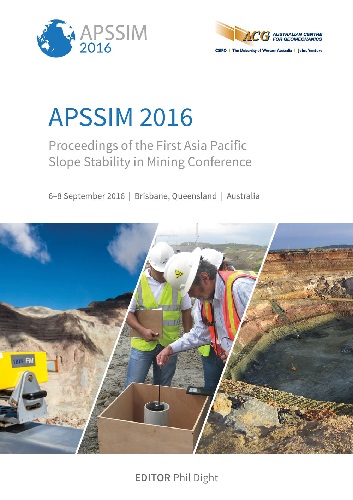Cowal gold mine — documentation of slope deformations due to mining to final pit walls — a case history

|
Authors: Crouse, RL; Wines, DR |
DOI https://doi.org/10.36487/ACG_rep/1604_02_Crouse
Cite As:
Crouse, RL & Wines, DR 2016, 'Cowal gold mine — documentation of slope deformations due to mining to final pit walls — a case history', in PM Dight (ed.), APSSIM 2016: Proceedings of the First Asia Pacific Slope Stability in Mining Conference, Australian Centre for Geomechanics, Perth, pp. 107-126, https://doi.org/10.36487/ACG_rep/1604_02_Crouse
Abstract:
The Cowal gold mine experienced two large failures in 2007. Subsequently, an automated prism monitoring network was installed. The challenge was to be able to interpret the prism data so that small pitward movements indicative of potential failure could be identified. The problem was that the initial movement would be of the same magnitude as the survey error, and would be difficult to detect. During mining of the surficial clays and saprolites, apparent pitward movement was identified on the east pit wall. A method was needed to determine whether this movement represented the onset of failure, or was just an artefact of rebound due to mining. After mining had proceeded past the surficial clays and saprolites, prism data was downloaded, and entered into Excel spread sheets, one file per prism. The movement data was manually manipulated to remove ‘jumps’ of large and small scale, after which a ‘best fit’ line was created through the final overall movement graph. This best fit line for a series of prisms on a cross-section was entered into a different Excel graph, with the X-axis as time, and the Y-axis as initial prism elevation minus the overall change in prism movement, which had been multiplied by 500 in order to make it easier to see the movement trend. The resulting ‘pseudo section’ graphs showed conclusively that the pitward movement observed in the prisms located in the surficial clays and saprolites were similar, being sub-parallel to the pitward movement observed in the prisms located in the primary rock below. These graphs showed that prism movement increased and decreased as mining continued or stopped in a certain pit area. The conclusion was that all of the observed apparent movement was due to rebound due to mining, and was not an indication of impending wall failure. Three-dimensional numerical analyses were also performed using 3DEC to assess the pit movements and the future stability of the slopes.
References:
Hoek, E & Diederichs, MS 2006, ‘Empirical estimation of rock mass modulus’, International Journal of Rock Mechanics and Mining Sciences, vol. 43, pp. 203–215.
Hoek, E, Kaiser, PK & Bawden, WF 1995, Support of underground excavations in hard rock, Rotterdam, Balkema.
Itasca 2013, 3DEC, Three-Dimensional Distinct Element Code, version 5.0, Itasca Consulting Group.
Lee, M, Mollison, L, Campbell, A & Litterbach, N 2010, ‘Rock Stresses in the Australian Continental Tectonic Plate – Variability and Controls’, in CY Chin, CI Massey, TJ McMorran, GM Pinches & AL Williams (eds), Proceedings of the 11th IAEG Congress – Geologically Active New Zealand, Auckland, CRC Press, Boca Raton.
Mercer, KG & Stacey, TR 2008, ‘A Generalized Time and Event Dependent Deformation Model for Unsupported Rock Slopes’, in Y Potvin, J Carter, A Dyskin & R Jeffery (eds), Proceedings of the First Southern Hemisphere International Rock Mechanics Symposium, Australian Centre for Geomechanics, Perth, pp. 481–492.
Sullivan, TD 1993, ‘Understanding pit slope movements’, in T Szwedzicki (ed.), Geotechnical Instrumentation and Monitoring in Open Pit and Underground Mining, Balkema, Rotterdam, pp. 435–445.
Sullivan, TD 2007, ‘Hydromechanical Coupling and Pit Slope Movements’, in Y Potvin (ed.), Slope Stability 2007, Australian Centre for Geomechanics, Perth, pp. 3–43.
Zavodni, ZM 2000, ‘Time-Dependent Movements of Open-Pit Slopes’, in WA Hustrulid, MK McCarter & DJA Van Zyl (eds), Slope Stability in Surface Mining, SME, pp. 81–87.
© Copyright 2025, Australian Centre for Geomechanics (ACG), The University of Western Australia. All rights reserved.
View copyright/legal information
Please direct any queries or error reports to repository-acg@uwa.edu.au
View copyright/legal information
Please direct any queries or error reports to repository-acg@uwa.edu.au